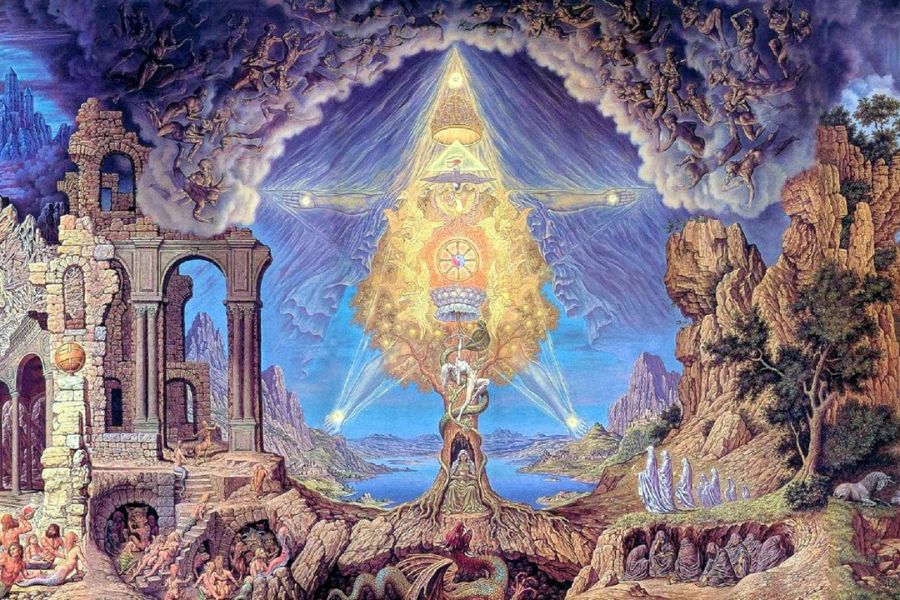Today, we will delve into a fascinating topic: Dream Yoga. We will explore this concept through the ancient wisdom of the Senoi People, the practice of Yoga Nidra, the Masters of the Himalayas, and Naropa’s Yoga, uncovering how each of these traditions contributes to the study of our inner psychology and, consequently, to profound changes in our being.
The Senoi are an indigenous culture from the Malay Peninsula, primarily residing in the mountainous regions. Famous for their unique social organization and skills in lucid dreaming, the Senoi also stand out for their child-rearing practices, which emphasize freedom, self-confidence, and creative expression.
Research conducted by social psychologist George Leonard and anthropologist Kilton Stewart in the 1940s and 1950s revealed a peculiar aspect of this society: their lack of severe conflict and the central role they place on dreams in their lives. According to the Senoi, dreams are powerful tools for resolving personal issues, reconciling conflicts, and achieving physical and mental health.
The Senoi’s approach to child-rearing is unique. From a young age, children are taught to manage their dreams and control dream content, believing this results in resilient and self-confident adults.
The Senoi use various practices to induce and control lucid dreams, including:
-
Dream Journals: Keeping a dream journal is a fundamental practice. This helps identify patterns and recurring themes in dreams, making their interpretation and manipulation easier.
-
Creative Visualization: Before sleeping, the Senoi practice visualizing specific scenarios or situations they wish to experience in their dreams, using vivid mental imagery and positive affirmations.
-
Clear Intentions: Before sleep, they set specific intentions about what they wish to achieve or explore during sleep.
-
Internal Dialogue: Throughout the day, the Senoi maintain a positive and reflective internal dialogue about their dreams, analyzing past experiences to actively engage with their dream content.
-
Reality Checks: During the day, they check whether they are dreaming by performing unusual actions or asking themselves, Am I dreaming now? This habit is also found in similar practices such as the SOL key, which we've discussed on our channel, allowing one to test if they are in the physical plane or astral.
These techniques are used to promote self-awareness, problem-solving, and healing through lucid dreams, profoundly impacting personal development.
The master Samael Aun Weor discusses the Senoi in his lectures, highlighting the importance of dreams to the tribe. He notes that the Senoi place decisive value on dreams, which become their primary tool for resolving significant life events. This approach helps avoid violence and conflict, leading to a peaceful and harmonious society.
In Samael’s view, the wisdom of the Senoi is a clear example of how dreams can be used for psychic and social development. Observing one’s own dreams, according to him, is essential for psychological and social stability.
Meanwhile, in India, an advanced meditation practice known as Yoga Nidra also focuses on exploring the mind during sleep. Yoga Nidra induces a state of deep consciousness similar to sleep, allowing practitioners to release tensions and expand their self-awareness.
This practice directly connects with several techniques used by the Senoi, such as complete relaxation and conscious breathing. In Yoga Nidra, the practitioner moves through the states of wakefulness, dreaming, and deep sleep, while remaining awake. Though Yoga Nidra is relaxing, it also serves as a tool to purify the Samskaras (deep impressions) and clear the mental field, essential for spiritual growth.
Soon, we will share a series of videos on this technique, with teachings from Master Swami Rama, so you can explore these practices fully.
In medieval India, the Buddhist sage Naropa developed Naropa's Yoga, which included a practice called Svapna Nidra Yoga, or Dreaming and Sleeping Consciously. Naropa emphasized the importance of maintaining consciousness during dreams, recognizing that these dream states offered a unique opportunity for self-reflection and spiritual growth.
While practices may vary, both the Senoi, Yoga Nidra, and Naropa's Yoga share a common goal: to consciously explore the states of sleep and dream in order to achieve lucidity and self-awareness, seeking a deeper connection with the subconscious and a fuller understanding of our inner nature.
We are not claiming that all dreams are transcendental. As Freud mentioned, many dreams are merely echoes of our daily life, reflecting the desires and patterns of the subconscious. However, it’s important to recognize that every dream, no matter how absurd or incoherent it may seem, carries meaning, reflecting the psychological state and the psychic centers it is associated with.
The key to self-knowledge lies in becoming a spy of one’s own dreams. As Plato said, Know a man by his dreams. Our thoughts, feelings, fears, hopes, and desires often manifest while we sleep. The wise person is able to use dreams as a profound means of self-discovery, often more revealing than the waking state.
Therefore, by investigating our dreams with sincerity and discipline, we can access deeper layers of the psyche, fostering an inner transformation that positively impacts our everyday life and our relationship with the world.




















